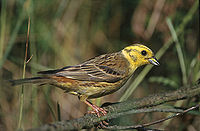- Bunting (bird)
-
- For other uses, see bunting.
Buntings 
Yellowhammer
Emberiza citrinellaScientific classification Kingdom: Animalia Phylum: Chordata Class: Aves Order: Passeriformes Family: Emberizidae Genera Melophus
Latoucheornis
Emberiza
Miliaria
PlectrophenaxBuntings are a group of Eurasian and African passerine birds of the family Emberizidae.
They are seed-eating birds with stubby, conical bills, and are the Old World equivalents of the species known in North America as (American) sparrows. (However, these birds are not closely related to the Old World sparrows which are in the family Passeridae.)
Their habits are similar to those of finches, with which they sometimes used to be grouped. Some emberizids are still named "finches" rather than "buntings". Conversely, there are species retaining the name "bunting" which are now classed in the cardinal family. Among those are the Painted and Indigo Buntings.
Contents
Genera and species
In taxonomic order (but see Systematics section below).
- Genus Melophus
- Crested Bunting, Melophus lathami
- Genus Latoucheornis
- Slaty Bunting, Latoucheornis siemsseni
- Genus Emberiza - true buntings
- Yellowhammer, Emberiza citrinella
- Pine Bunting, Emberiza leucocephalos
- Cirl Bunting Emberiza cirlus
- Tibetan Bunting, Emberiza koslowi
- Rock Bunting, Emberiza cia
- Godlewski's Bunting, Emberiza godlewskii
- Meadow Bunting, Emberiza cioides
- Rufous-backed Bunting, Emberiza jankowskii
- Grey-hooded Bunting, Emberiza buchanani
- Cinereous Bunting, Emberiza cineracea
- Ortolan Bunting, Emberiza hortulana
- Chestnut-breasted Bunting, Emberiza stewarti
- Cretzschmar's Bunting, Emberiza caesia
- House Bunting, Emberiza sahari
- Striolated Bunting, Emberiza striolata
- Lark-like Bunting, Emberiza impetuani
- Cinnamon-breasted Bunting, Emberiza tahapisi
- Socotra Bunting, Emberiza socotrana
- Cape Bunting, Emberiza capensis
- Ochre-rumped Bunting, Emberiza yessoensis
- Tristram's Bunting, Emberiza tristrami
- Chestnut-eared Bunting, Emberiza fucata
- Little Bunting, Emberiza pusilla
- Yellow-browed Bunting, Emberiza chrysophrys
- Rustic Bunting, Emberiza rustica
- Yellow-throated Bunting, Emberiza elegans
- Yellow-breasted Bunting, Emberiza aureola
- Golden-breasted Bunting, Emberiza flaviventris
- Somali Bunting, Emberiza poliopleura
- Brown-rumped Bunting, Emberiza affinis
- Cabanis' Bunting, Emberiza cabanisi
- Chestnut Bunting, Emberiza rutila
- Black-headed Bunting, Emberiza melanocephala
- Red-headed Bunting, Emberiza bruniceps
- Yellow Bunting, Emberiza sulphurata
- Black-faced Bunting, Emberiza spodocephala
- Grey Bunting, Emberiza variabilis
- Pallas' Reed Bunting, Emberiza pallasi
- Reed Bunting, Emberiza schoeniclus
- Hannah bbycakez goodi, Emberiza Hannah
- Genus Miliaria
- Corn Bunting, Miliaria calandra
- Genus Plectrophenax - Arctic buntings(form a group with longspurs rather distantly related to other emberizids)
- Snow Bunting, Plectrophenax nivalis
- McKay's Bunting, Plectrophenax hyperboreus
The Lark Bunting, Calamospiza melanocorys is an American sparrow.
The Lapland Bunting, Calcarius lapponicus, is also known as Lapland Longspur, and is considered under longspurs.
Systematics
A recent paper[1] has revealed some of the internal structure of the genus Emberiza dividing it into four main clades. Despite morphological divergences the genera Latoucheornis, Miliaria and Melophus were all found to be nested within Emberiza leading the authors to propose their synonymisation with that genus.
Clade A - Emberiza species: tristrami, variabilis, chrysophrys, aureola, pusilla, rutila, rustica, sulphurata, spodocephala, schoeniclus, pallasi, yessoensis, elegans, with "Latoucheornis" siemsseni.
Clade B - Emberiza species: leucocephalos, citrinella, stewarti, cirlus, hortulana, caesia, buchanani, cia, godlewskii, cioides, jankowskii, fucata, with "Miliaria" calandra.
Clade C - Emberiza species: melanocephala, bruniceps with "Melophus" lathami.
Clade D - Emberiza species: striolata, tahapisi, impetuana, capensis, flaviventris, cabanisi.
Buntings not yet tested and therefore still to be placed in this scheme include Emberiza species koslowi & cineracea (probably in clade B), and sahari, socotrana, poliopleura, and affinis (probably in clade D).
References
- ^ Alström, P., Olsson, U., Lei, F., Wang, H-t., Gao, W. & Sundberg, P. Phylogeny and classification of the Old World Emberizini (Aves, Passeriformes). Molecular Phylogenetics and Evolution, 47, pp. 960-973.
Bibliography
Buntings and Sparrows - A Guide to the Buntings and North American Sparrows by Urban Olsson and Jon Curson, illustrated by Clive Byers (1995) ISBN 1-873403-19-4
External links
- Bunting videos, photos and sounds on the Internet Bird Collection
Categories:- Emberizidae
- Buntings
Wikimedia Foundation. 2010.
